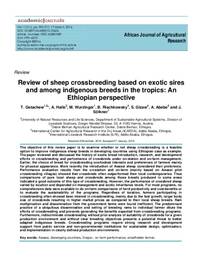Review of sheep crossbreeding based on exotic sires and among indigenous breeds in the tropics: An Ethiopian perspective

Authors:
The objective of this review paper is to examine whether or not sheep crossbreeding is a feasible option to improve indigenous sheep breeds in developing countries using Ethiopian case as example. The paper reviewed and discussed the history of exotic breed introduction, research, and development efforts in crossbreeding and performance of crossbreds under on-station and on-farm management. Earlier, the choice of breed for crossbreeding overlooked interests and preferences of farmers mainly for physical appearance. More recently the introduction of Awassi sheep considered their preference. Performance evaluation results from the on-station and on-farm (mainly based on Awassi pilot crossbreeding villages) showed that crossbreds often outperformed their local contemporaries. Thus comparisons of pure local sheep and crossbreds among those breeds produced in some areas indicated a good outcome of this type of crossbreeding. However, the performance of crossbred sheep varied by location and depended on management and exotic inheritance levels. For most programs, no comprehensive data were available to do on-farm comparisons of herd productivity and cost-benefits or to evaluate the sustainability of the programs. Regardless of location, farmers participating in crossbreeding often showed keen interest in crossbreeding, mainly due to the fast growth, larger body size of crossbreds resulting in higher market prices as compared to their local sheep breeds. Ram multiplication and dissemination from the government farms were found inefficient. The predominant practice of a ubiquitous dissemination and selling of breeding rams to individual farmer dilute the efforts of crossbreeding and prevents generating the benefits expected from crossbreeding programs. Furthermore, indiscriminate crossbreeding without prior analysis of suitability of crossbreds for a given production environment and without clear breeding objectives presents a potential threat to better adapted indigenous breeds. Crossbreeding programs require strong research and development support from public service and non-governmental institutions for sustainable design, optimization, and implementation in clearly defined production environments.
